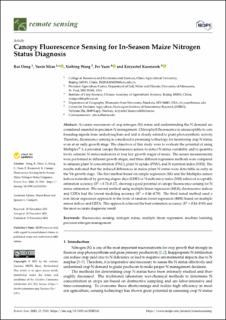| dc.contributor.author | Dong, Rui | |
| dc.contributor.author | Miao, Yuxin | |
| dc.contributor.author | Wang, Xinbing | |
| dc.contributor.author | Yuan, Fei | |
| dc.contributor.author | Kusnierek, Krzysztof | |
| dc.date.accessioned | 2022-03-02T14:34:28Z | |
| dc.date.available | 2022-03-02T14:34:28Z | |
| dc.date.created | 2022-02-04T12:33:37Z | |
| dc.date.issued | 2021-12-17 | |
| dc.identifier.citation | Remote Sensing. 2021, 13 (24), 1-20. | en_US |
| dc.identifier.issn | 2072-4292 | |
| dc.identifier.uri | https://hdl.handle.net/11250/2982606 | |
| dc.description.abstract | Accurate assessment of crop nitrogen (N) status and understanding the N demand are considered essential in precision N management. Chlorophyll fluorescence is unsusceptible to confounding signals from underlying bare soil and is closely related to plant photosynthetic activity. Therefore, fluorescence sensing is considered a promising technology for monitoring crop N status, even at an early growth stage. The objectives of this study were to evaluate the potential of using Multiplex® 3, a proximal canopy fluorescence sensor, to detect N status variability and to quantitatively estimate N status indicators at four key growth stages of maize. The sensor measurements were performed at different growth stages, and three different regression methods were compared to estimate plant N concentration (PNC), plant N uptake (PNU), and N nutrition index (NNI). The results indicated that the induced differences in maize plant N status were detectable as early as the V6 growth stage. The first method based on simple regression (SR) and the Multiplex sensor indices normalized by growing degree days (GDD) or N sufficiency index (NSI) achieved acceptable estimation accuracy (R2 = 0.73–0.87), showing a good potential of canopy fluorescence sensing for N status estimation. The second method using multiple linear regression (MLR), fluorescence indices and GDDs had the lowest modeling accuracy (R2 = 0.46–0.79). The third tested method used a non-linear regression approach in the form of random forest regression (RFR) based on multiple sensor indices and GDDs. This approach achieved the best estimation accuracy (R2 = 0.84–0.93) and the most accurate diagnostic result. | en_US |
| dc.language.iso | eng | en_US |
| dc.publisher | MDPI, Basel, Switzerland | en_US |
| dc.rights | Navngivelse 4.0 Internasjonal | * |
| dc.rights.uri | http://creativecommons.org/licenses/by/4.0/deed.no | * |
| dc.title | Canopy fluorescence sensing for in-season maize nitrogen status diagnosis | en_US |
| dc.type | Peer reviewed | en_US |
| dc.type | Journal article | en_US |
| dc.description.version | publishedVersion | en_US |
| dc.rights.holder | © 2021 by the authors | en_US |
| dc.source.pagenumber | 1-20 | en_US |
| dc.source.volume | 13 | en_US |
| dc.source.journal | Remote Sensing | en_US |
| dc.source.issue | 24 | en_US |
| dc.identifier.doi | 10.3390/rs13245141 | |
| dc.identifier.cristin | 1997783 | |
| dc.source.articlenumber | 5141 | en_US |
| cristin.ispublished | true | |
| cristin.fulltext | original | |
| cristin.qualitycode | 1 | |

